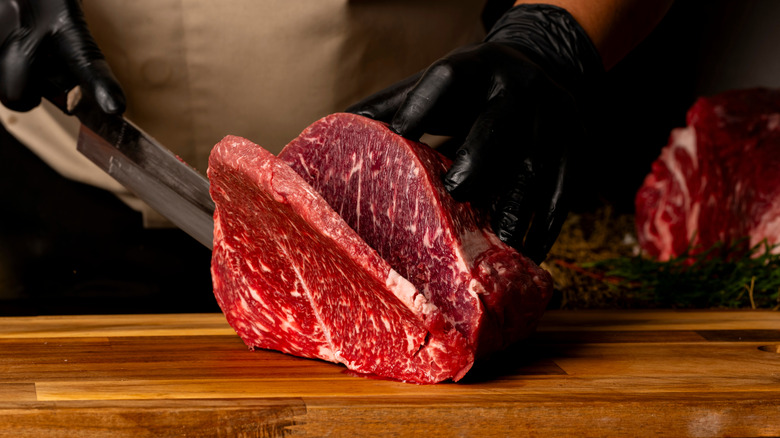What Happens When You Don't Cut Meat Against The Grain?
Peruse steak recipes, and certain steps start to appear ubiquitously. You'll be instructed to warm your meat up to room temperature before cooking, let the steaks rest after cooking on the pan or grill, and cut against the grain to serve. Such considerations are more than ritual; there's proven effects on the beef's composition and flavor. Yet what if you've made a mistake (or are feeling particularly rebellious) and improperly slice into the beef?
To say the result is disastrous would be dramatic, but depending on the cut, the mouthfeel will be noticeably impacted. After all, the technique's aim is to reduce muscle fibers. These long, tough strands are bound by connective tissue, and work to secure a cow's muscle to bone. They run in parallel throughout the meat, with greater concentration in more muscular parts of the animal.
Once cooked for a normal length of time, these strands don't dissolve. Instead, they lend a tough and chewy texture: Fibers take extra effort to bite through. So by cutting meat perpendicularly, you're shortening their length, thereby making beef taste more tender. However, slice into a different direction, and you'll get more fiber in each bite, with the worst move being a cut in parallel. So really, when you don't cut meat against the grain, you're giving diners added chewing work.
Failing to slice against the grain elongates chewy muscle fibers
With the dizzying range of beef cuts, the downfalls of an improper slice depend on the application. If you're butchering the perfect cut of meat for a beef stew, the consideration is less important: The structure of small pieces will fall apart during slow-cooking anyways. In fact, dishes like ropa vieja purposefully cut along the grain for added structure; a rare exception.
Furthermore, there are also several beef cuts in which the fibers are so fine, the slicing style barely matters. Typically, these are the more coveted steak cuts sourced from the loin and tenderloin. If you painstakingly prepare a well-marbled ribeye, New York strip or filet mignon, and then don't cut against the grain, the beef will still be tender. Such cuts also often have fibers that run in unusual directions, like in parallel to the height of the steak, or incongruently throughout the beef. Noting the direction is always a good idea, but on these particular cuts, the angle at which you slice is less important.
Most other major beef options do come with a heftier dose of muscle. With these, when you don't cut against the grain, you will make the muscle fibers front and center. It's essential to cut a skirt steak the right way to avoid tough, chewy textures, since the beef part is extra fibrous. And the same logic applies to cuts like flank, hangar, or brisket — which is often sliced up prior to cooking. Thankfully, such options all possess easily-spotted fibers, making an improper cut more likely intentional than accidental.

